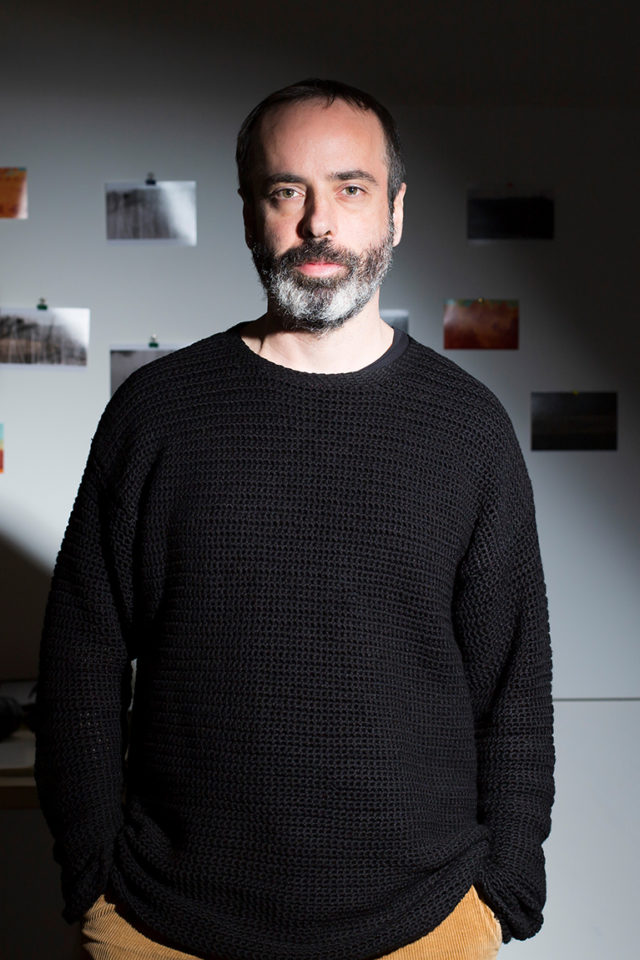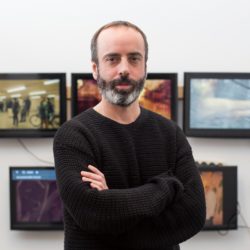
STORIES OF BERLIN
- Exhibition
- Fresh A:I:R
- August 26, 2023
Opening: 26.08.2023, 6 pm, as part of Long Night of Museums
Visit us: 26. August – 24. September 2023
Tue + Wed: 10 am – 6 pm
Thu – Sun: 12 – 8 pm
Mondays closed
Location: UN Project Space (Bülowstr. 97, 10783 Berlin)
The exhibition »STORIES OF BERLIN« takes place on the occasion of the fifth anniversary of Fresh A.I.R., the artist scholarship program of Stiftung Berliner Leben. The exhibition features video-artistic works created by former Fresh A.I.R. fellows who were active in Berlin between 2020 and 2022. In their videos, Tomáš Kajánek (CZE), Lotte Reimann (GER) and Marc Samper (ESP) engage with the past and present of Berlin and its inhabitants, opening up sensitive approaches to subcultures and offline realities. Surprising confessions as well as unique glimpses into the family archives allow the viewers to enter areas that mostly remain unnoticed by the mainstream media. In this way, some new sides of Berlin and its inhabitants can be discovered.
It was golden – Our exhibition opening
The opening of the Fresh A.I.R. anniversary exhibition »STORIES OF BERLIN« as part of the Long Night of Museums 2023 was a success. Following on from this year’s motto »Sounds of Berlin«, in which the sounds of the city blended into a pulsating soundscape in the mild summer night, visitors to the exhibition were immersed in a space of tranquillity and intimacy and caught a glimpse of a Berlin far beyond the tourist view.
Dr. Hans-Michael Brey, Chairman of the Stiftung Berliner Leben, opened the evening with a welcoming speech. Afterwards, the artistic director and curator of the programme Janine Arndt introduced the contexts of the exhibition. One of the exhibited artists, Lotte Reimann, was there in person and told the visitors in her own words about her video work »Beyond«. After a toast to many more successful years of international artist promotion within the framework of Fresh A.I.R., the guests took the opportunity for a personal exchange with those responsible and the artist.
The Fresh A.I.R. team also used the festive occasion to express their gratitude to all those involved in the past 5 years. With their competence, passion and commitment, they have all contributed to filling Fresh A.I.R. with life and making the scholarship programme what it is today. They have thanked the artists, the generous sponsors and supporters, the external advisors in the selection process, the mentors and authors, and the tireless team of the Stiftung Berliner Leben. The external contributors are listed below.
Thanks to the members of our jury:
Janine Arndt (Artistic Director Fresh A.I.R.) | Dr. Hans-Michael Brey (Board of Foundation Berliner Leben) |
Heike Dander (Executive Curator LUMAS Gallery) | Prof. Dr. Burcu Dogramaci (Ludwig Maximilians University of Munich) | Prof. Susanne Weirich (University of Duisburg-Essen) | Katrin Göhler (Fundraising Manager Malteser Hilfsdienst e.V.) | Sven Harke-Kajuth (Head of Digitalisation & Corporate Services, Gewobag) | Dr. Larissa Kikol (Independent art critic and historian) | Dr. Heiderose Langer (Former Managing Director of the Erich Hauser Art Foundation) | Dr. Noor Mertens (Art Museum Bochum) | Prof. Dr. Helen Koriath (Art-Historical Institute, Osnabrück University) | Prof. Dr. Barbara Kaesbohrer (Art Educational Institute, Osnabrück University) | Dr. Olena Lykhovodova (Curator of Ukrainian Programme at the Goethe-Institute in Exile in Berlin) | Tim Renner (Former State Secretary for Culture in Berlin) | Jan Sauerwald (Former Director URBAN NATION Museum) | Paul Spies (Chief Curator of the State of Berlin at the Humboldt Forum) | Prof. Dr. Melanie Ulz (Heidelberg Centre for Transcultural Studies, Heidelberg University), Dr. Silke Vry (Art historian and children’s book author) | Yasha Young (Former Director URBAN NATION Museum)
Our participating artists:
Class 1 (10/2018 – 3/2019) Dot Dot Dot (NOR) | Herakut (DEU) | Li-Hill (USA/CAN) | Louis Masai (GBR) |
Ludo (FRA) | Nespoon (POL) | Onur (CHE) | Quintessenz (DEU) | SellFable (NLD) | Snik (GBR) | Mia Florentine Weiss (DEU) | Wes 21 (CHE)
Class 2 (4/2019 – 9/2019) Nadine Baldow (DEU) | Sarah Bernabucci (ITA) | Bifido (ITA) | Rafael Bresciani (ITA) | Liviu Bulea (ROU) | Tania Cellini (ITA) | Anietie Ekanem (GBR) | Alexis Fidetzis (GRC) | Faisal Hussain (GBR) | Alexandra Oancea (ROU) | Ossi Pirkonen (FIN) | Sibomana (ITA/BEL) | Alexandros Simopoulos (GRC) | Alina Suarasan (ROU) | Maja Tomaszewska (POL) | Wandal (DEU)
Class 3 (10/2019 – 3/2020) Bojan Stojcic (BIH) | BYE (ESP) | Dani Gherca (ROU) | DURA (DEU) | Fanny Spång (SWE) | JUKAI (ITA) | Kerasia Tsiantzi (GRC) | M05K (NLD) | Nika Ham (SVN) | Stephen Burke (IRL)
Class 4 (10/2020 – 3/2021) Alexis Dworsky (DEU) | Danny Vines (GBR) | Felicitas Fäßler (DEU) | Giulia
Berra (ITA) | Marc Samper (ESP) | META-colectivo (ESP) | Mots (PRT & POL) | Poppy French (GBR) | Valeriana Berchicci (ITA)
Class 5 (4/2021 – 9/2021) Rita António (DEU) | Aïda Gómez (ESP) | Antigoni Tsagkaropoulou (GRC) | Denis Cherim (ROU) | Hannah Skinner (GBR) | Joanna Simson (SWE) | LiHenn (DEU) | Lotte Reimann (DEU) | Marjolein van der Meer (NLD) | Vince Donders (NLD) | William St Leger (IRL)
Class 6 (10/2021 – 3/2022) Linda Söderholm (FIN) | Marta Bogdanska (POL) | Maria Pichel Llaquet (ESP) | Tomáš Kajánek (CZE) | Ecaterina Stefanescu (ROU) | Andreas Langfeld (DEU) | Regina Vitányi (HUN) | Ludivine Thomas-Andersson (FRA) | Denise Lobont (ROU) | Nikki Spanou (GRC) | Aslı Dinç + Zeynep Okyay (TUR)
Class 7 (4/2022 – 12/2022) Denise Ackerl (AUT) | Anna Barnaföldi (HUN) | Eleni Danesi (GRC) | Razvan
Dumitru (ROU) | Samuel Henne (DEU) | Oscar Lebeck (DEU) | Karin Lindstén (SWE) | Johnny Pavlatos (GRC) | Sonia Sagan (SWE) | Elektra Stampoulou (GRC) | Ilona Stutz (CHE)
Class 8 (1/2023 – 12/2023) Apl315 (UKR) | CHLEPA (POL) | Katya Craftsova (UKR) | Rita Ferreira (PRT) |
Marjolein Guldentops (BEL) | Zuzanna Odolczyk (POL) | Diana-Elena Paun (ROU) | Oana Maria Pop (ROU) | Tanel Rander (EST) | Anastasia Strockova (CZE) | Dana Venezia (ITA/ISR)

MORE

The culturally ›enlightening‹ narrative about love and reproduction »The Birds and the Bees« is revisited and playfully de-familiarised. The juxtaposition of these narratives and the colour changes of the images open up associative spaces that stimulate reflection on the diversity of identity, love, and desire.
MORE

One noteworthy aspect of Haiku is its endeavour to manifest the appearance of nothingness through the expression of minimal events. Haiku represents reality as a vanishing act, employing a paradoxical mode of thinking similar to that found in Zen philosophy: Haiku is the cancellation of what happens, as it happens.
MORE
Download Flyers:

(c) Photographs slideshow: Diana-Elena Păun
(c) Portraits: Victoria Tomaschko

















